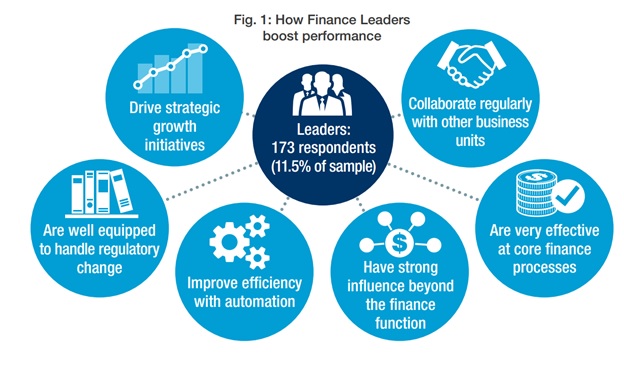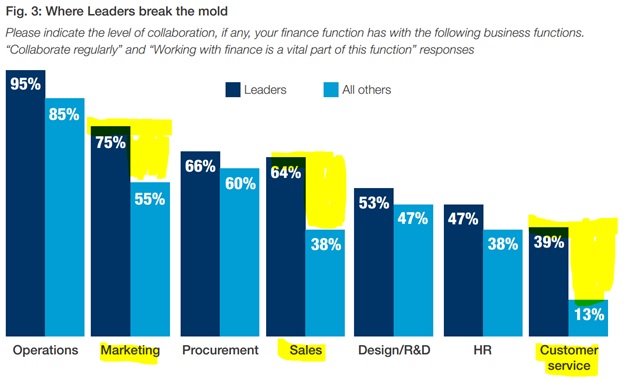6 Traits of Finance Leadership
Part 1: Efficiency
Oxford Economics and SAP conducted a 1,500-person CFO survey in the Spring of 2017, looking at what traits an organization embodies that lead to “finance leadership.” And of these 1,500 respondents?
Just 11.5% qualified as “Leaders.”
Why this matters: Finance Leaders report growth in market share almost 2X more than non-leaders.
This elite group of “Leaders” demonstrated 6 traits that boost business performance and efficiency and at the same time enhance GRC (governance, risk, compliance).

Efficiency as Top Business Goal
“Efficiency through automation” was 1 of the 6 traits of Finance Leaders. More than 50% of respondents cited efficiency across their organization as a top business goal. In fact, “efficiency” was 1 of the top 3 most frequently cited goals.
Due to the transaction heavy and repetitive nature of finance, this function tends to be a major area of opportunity for streamlining and automation.
The report cited a partner at Ernst & Young (EY) who recalled that the identification of this back in the 1990’s lead to widespread adoption of utilizing offshore assistance. But now, he said, this work is coming back onshore and is being performed by virtual robots.
EY is looking at developing virtual robot based services that could boost productivity by 30-40% over the next 2 years.
Among the Finance Leaders, over 70% agree that automation:
- Plays a role in improving their efficiency, and
- Gives them more bandwidth.
So it’s safe to conclude that those that are not embracing automation “are sacrificing growth.”
Additionally, virtual robot based automation resolves errors in data entry from repetitive work. This in turn improves customer experience (CX), which allows customers to breathe a sigh of relief as they no longer have to audit their provider constantly.
Impediments to Success in Efficiency
Despite knowing the pot of gold is imminent, finding the path to efficiency isn’t easy. There are a number of impediments that stall or outright prevent some organizations from becoming more efficient. Among these roadblocks in taking the path toward automation, 1 of the top 5 reasons cited was avoiding disruption to business operations.
Implementing any technology can be a challenge. For any CFO that has migrated their ERP (enterprise resource planning) or accounting system, this is an acute and painful memory. While not as disruptive, implementing virtual robots and automation can be challenging to accommodate. This is particularly present in the cyclical area of finance, which faces monthly, quarterly, and annual processes that don’t leave a lot of time to introduce a new technology.
Among the other top 5 impediments cited were a lack of workforce skills and lack of system integration. Usually, the finance team does not have technical resources at their disposal and system integration can be a daunting task.
Regardless of these impediments, over 90% of the 1,500 survey respondents cited technology as being important to streamlining the finance function – which was part of the top business goals. And among Finance Leaders, 98% felt technology was important in this endeavor.
The Headcount Impact of Efficiency
Headcount impact tends to be a top concern when considering “streamlining” of a function. In this survey, Oxford Economics found that while CFO’s are committed to improving efficiency within finance, it does not necessitate a reduction in staff.
Out of the 1,500 respondents, only 3% had experienced a reduction in staff. And specifically, automation’s impact on finance jobs was only seen at 4% of companies. That is good news for those considering automation.
As organizations look for ways to grow efficiency, they join the ranks of companies showing higher growth in revenue and profit margins. Of course, this affords these organizations the ability to hire more people across the organization, including in finance.
Taking a longer-term lens, automation does not reduce headcount, it helps finance become more efficient in serving business goals. By moving their staff away from tedious and repetitive tasks that can now be performed by virtual robots, finance leaders can prepare for other disruptors such as blockchain and artificial intelligence (AI).
In fact, a more productive finance department will have an expanded role as these new technologies become mainstream. The finance team is already being tapped with Big Data projects and handling analytics. Accordingly, they become the guides to the rest of the organization and can help enable growth as a result of their insights.
Overcoming Obstacles to Efficiency
The Oxford Economics and SAP study found that disruption to operations, lack of workforce skills, and lack of system integration were impediments to achieving the business goal of organizational efficiency. To overcome this, CFO’s can look for ways to minimize the impact of these challenges.
For example, instead of buying technology and implementing it in-house, they can take a more modern approach. With nearly everything available ‘as a service,’ automation can also be consumed as a service.
To overcome challenges in workforce skills, organizations can tap technology experts. Consultants can help the organization assess areas that have the most ‘bang for the buck’. This outside expertise has the benefit of being objective and also bringing other experiences and observations to be truly insightful.
Consultants can also provide technical resources and have the capability to create integration bridges to reap the benefits of consolidating data. Not only can they find integration tools, but they can also build and implement them without heavily disrupting the day to day workflow within the organization.
Utilizing automation as a service allows the organization to switch to an operating expense model with less impact on cashflow than the legacy approach of buy and build. The service based approach ensures that technology doesn’t get outdated as compared to buying or leasing software.
Regardless of the approach, technology has a key role in the growth, sustainability, and differentiation for organizations of the future. Automation and virtual robots are one area that finance leaders can explore to help them achieve organization-wide efficiency.
[This article is based on the survey by Oxford Economics and SAP.]
Collaboration

Cybersecurity 1 of top 3 business risks. Those viewed as Leaders are more aware and cognizant of the impact of cybersecurity risks than non-leaders.


